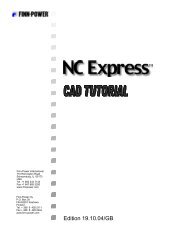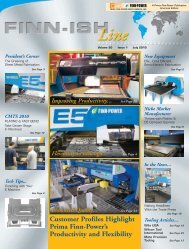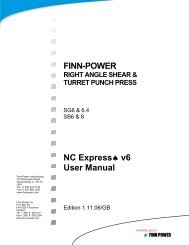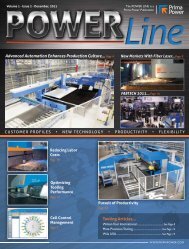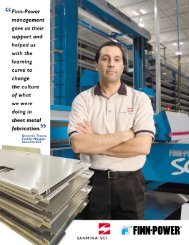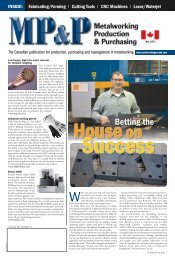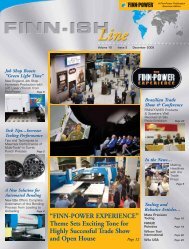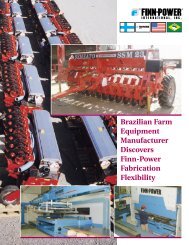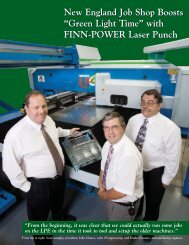Stand-Alone Punch machine user manual - Finn-Power International ...
Stand-Alone Punch machine user manual - Finn-Power International ...
Stand-Alone Punch machine user manual - Finn-Power International ...
Create successful ePaper yourself
Turn your PDF publications into a flip-book with our unique Google optimized e-Paper software.
5 NESTING<br />
Proper nesting yields savings in material. NC Express’ nesting engine will<br />
automatically layout the most complex part onto a defined plate in the most efficient<br />
manner possible by means of True Shape Nesting. Plate information, such as<br />
dimensions, material type and thickness are defined; once the properties are setup the<br />
plate definitions are defined to then create a nest. NC Express will automatically<br />
determine the optimum placement of a part, or multiple parts, within the defined<br />
plate.<br />
NC Express’ goal of nesting is to automatically provide an efficient arrangement of<br />
shapes within the context of the <strong>machine</strong> on which a part is to be produced according<br />
to the parameters specified by the <strong>user</strong>. Parameters are available within the nesting<br />
engine to assist the <strong>user</strong> in modifying the nest result. Varying these parameters will<br />
significantly affect the outcome of the plate, allowing a <strong>user</strong> to conform to certain<br />
nest situations. Along with parameters set, when nesting there are automatic features<br />
of the nest engine that will check for proper tool usage and placement within the<br />
<strong>machine</strong>s working area. In unison, once properties are setup and parameters are<br />
chosen nesting parts should be a very efficient process.<br />
Within the following section many features, either automatic or parameters to set, will<br />
be covered to understand how to attain automation when creating <strong>machine</strong> efficient<br />
nests.<br />
5.1 NC Express Nesting Theory<br />
Plate size, material type and thickness, and plate definitions are the main items<br />
required to create a nest. NC Express gives the ability to store this information to be<br />
retrieved automatically when nesting. NC Express, in its entirety, is solely based on<br />
material type and thickness from start (part creation) to finish (NC file). Multiple<br />
plate sizes (raw material) are defined within a database for each material type and<br />
thickness setup within NC Express; in addition to plates defined, parts are stored<br />
within a parts database. When nesting, parts and plates that have been defined with a<br />
specific material type and thickness are only available within the current nest<br />
according to the nest properties. Plate definitions (clamp information and plate<br />
margins) are set accordingly to create a working area within a given plate.<br />
Overall, the ultimate goal is to allow easy setup when creating a nest. The following<br />
three sections will explain the application of features within NC Express to produce<br />
an optimal level of efficiency during the nesting process.<br />
5.1.1 Plates Database<br />
Before nesting, plate information can be stored within a database to be retrieved<br />
when creating nests. Stored plate information, within the Plates Database, is the<br />
actual raw material on hand. Within the Plates Database, a plate is setup according<br />
to dimensions, quantity on hand, material type and thickness, priority as well as<br />
more useful information. When a nest is created, NC Express searches the Plates<br />
5-78




